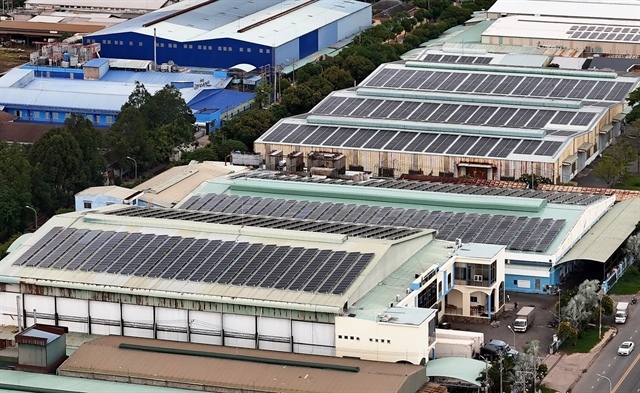City sci-tech market to boost innovation
City sci-tech market to boost innovation
The municipal administration plans to have 70 per cent of industrial production enterprises in HCM City invest at least eight per cent of their pre-tax profits in developing and applying new technologies by 2020.

Officials said the plan reflects the awareness that technological renovation is an urgent need should the nation want to remain competitive as it deepens its international integration process.
A report compiled by the Viet Nam News Agency (VNA) last week notes that while a science and technology market, where innovative solutions are developed and sold, has advanced considerably in the country in recent years, many difficulties remain in connecting sellers and buyers.
The report says that at present, HCM City has about a million scientists, including academics, engineers and other technology experts, working in around 100 universities and colleges. The city also has 218 science and technology institutes and over 100,000 enterprises.
This has meant that quite a few good scientific and technological innovations have been developed, but before 2012, the transfer of technology from developers to users was very poor.
Tech trade
In 2012, realising the important role played by technological innovation in the city’s economic development, HCM City authorities decided to pilot a technology transaction floor. The aim was to turn it into a focal point in technology transfer by the year 2018.
Besides this, city authorities have regularly organised Techmart Fairs, Techmart Online and Techmart Daily so that the public and enterprises are aware of technological innovations. Such innovations could help improve the living standards of the community and also enhance productivity of enterprises.
Techmart Daily has thus far drawn the participation of 70 entities that have put on offer over 170 technological innovations and equipment.
Nguyen Khac Thanh, Deputy Director of the HCM City Department of Science and Technology, said the city’s sci-tech market was one of the five busiest markets in the city besides the real estate market and consumer goods market.
“This is an indication of the important role played by the sci-tech market in the course of the city’s socio-economic development”, Thanh said.
He said those participating in the transaction floor were mainly enterprises (about 80 per cent), professional and amateur innovators (11 per cent), and the remaining were staff from research institutes and universities.
Thanh also said that in 2016, the city’s technology transaction floor received 145 orders for technology and equipment and provided relevant information to more than 80 enterprises. Seven technology transfer contracts worth almost VND8 billion (nearly $360,000) were signed on the transaction floor last year.
Luong Tu Son, deputy director of the HCM City Centre for Information and Statistics for Science and Technology, said that in the 2012-2016 period, some 40 technology transfer contracts worth about VND50 billion (more than $2.2 million) were signed, and this was a positive sign.
Weak links
The VNA report quoted Tran Anh Tam, deputy director of the Research and Development Department under the General Corporation of Fertiliser and Petro Chemicals, as saying connectivity between research institutes, universities and enterprises was very poor.
To improve this situation, state management agencies should act as matchmakers between scientists and enterprises, said Huynh Quyen, Vice Principal of the Science and Technology Faculty of the HCM National University.
Last year, the HCM City People’s Committee issued a five-year (2016-2020) plan to develop the city’s sci-tech market, showcasing its intent to facilitate the application of advanced scientific and technological developments in production.
Pham Van Xu, director of the Science Department, under the HCM City’s General Department of Science and Technology, said that in the near future, the city will invest more in science and technology, particularly in areas that directly address urgent social and market issues.
It will also encourage the establishment of a “linkage chain” between enterprises and research institutes, he said.
Enumerating specific targets for the sci-tech market, Nguyen Khac Thanh, deputy director of the city’s Department of Science and Technology, said: “In the 2016-2020 five-year period, the city will try to achieve an annual growth of about 15 percent normal sci-tech transactions, and about 20 percent in hi-tech areas prioritised by the central Government.
Time gap
HCM City ranks first in the country for the number of patent applications, the VNA report said.
From 2008-2016, 1.635 applications were registered, 251 of which were approved.
Huynh Quyen, acting director of the Faculty of Science and Technology at the Viet Nam National University, HCM City, told VNA that commercialisation of patented innovations had mainly taken place at the Bach Khoa (Polytechnic), Nong Lam (Agriculture and Forestry), Cong Nghiep (Industry) universities and some faculties under the HCM City University.
For example, in 2012 alone, the HCM City Polytechnic University earned VND90 billion ($3.95 million) from commercialising their innovations.
Thanh said it typically takes quite a long time and a lot of efforts to develop a new technology, make it into a product and then commercialise it. “The whole process might take as much as a decade,” he said.
A different perspective was offered by Hoang To Nhu, deputy director of the HCM City Department of Intellectual Property Rights. “We can commercialise the innovation, right at the outset, when the idea is formed. This is a good way to invite interested people or organisations to join research and development efforts,” she said.



















